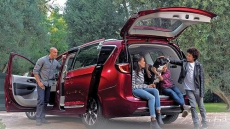Last year, the Lexus Executive Sedan, or ES as most people know it, finally received a much needed injection of style following a significant refresh. The changes involve an exterior refresh, more interior luxury, and the addition of Lexus Safety System + technology suite.
The ES has long been regarded by many as the most “vanilla” product in Lexus’ lineup, offering a comfortable driving experience but not much in the way of excitement. To try and alter that perception, designers have given the car a proper interpretation of the trademark spindle grille, framed in elegant brushed “satin chrome.” The headlights, once shapeless rectangles, now possess curves to match the contour of the grille and are equipped with LED projectors.
The arrowhead daytime running lights, as seen on models such as the IS and RC, are integrated within the headlight housing rather than inset into the bumper for a cleaner and less cluttered look. The fog lamps, previously round, are contoured and pushed out further to make the vehicle appear wider. The updates continue at the back where the taillights have been slimmed down and a lower rear lip garnish added to the bumper.
When you look at the profile of the ES, you really get a sense of how long is. As a reference: the total length of the IS is 4,665 millimetres, the RC 4,695 mm, and the ES 4,910 mm. As a result, rear passengers especially can lounge out, taking advantage of 1,015 mm of legroom, which is nearly as much as up front (1,065 mm).
The rest of the interior is classic Lexus: functional and just the right amount of luxury. The seats feature a quilted pattern for 2017, and the multi-information display on the instrument cluster is a little larger (4.2 inches) so vehicle stats and route guidance is easier to read. Love it or hate it, the Remote Touch Interface mouse/joystick combo is still used as the main source of infotainment control, although a couple of new “Enter” buttons should assist the input process.
Dashboard storage space remains limited, with only a covered ashtray cubby and pair of small cupholders for people to place their belongings. My cellphone was not happy.
The same engine offerings exist as before – DARPAN tested the 2.5-litre Atkinson-cycle four cylinder in the 300h, mated to an electronically-controlled continuously variable transmission, making a net 200 horsepower. Output is average yet smooth, about what you would expect from a hybrid. There is a driver-selectable sport mode to modify vehicle characteristics, like gear ratios, to become more aggressive for slightly increased performance. Since we’ve been comparing the ES to its sportier siblings, the brakes in the full-size sedan feel squishier.
After a week spent in the car, the computer reported a fuel consumption of 8.3 L/100 km in mostly city driving. Gentler drivers may be able to achieve numbers closer to Lexus’ estimates of 5.8 in the city and 6.1 on the highway.
Highlights (as tested):
MSRP: $54,750
Motor: 2.5-litre Atkinson-cycle four cylinder
Horsepower: 200 (net)
Torque (lb-ft): 156 @ 4,700 rpm
Gearbox: Electronically-controlled continuously variable transmission
Layout: Front engine, front-wheel drive
Fuel economy: 8.3 L/100 km mixed city/highway (observed)








